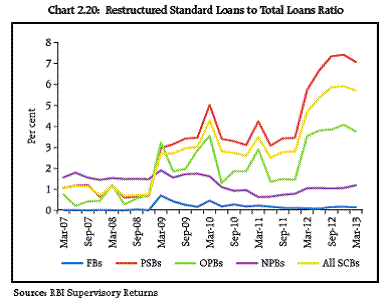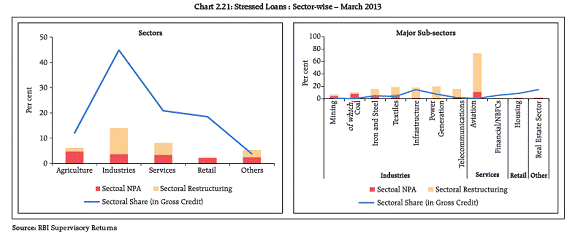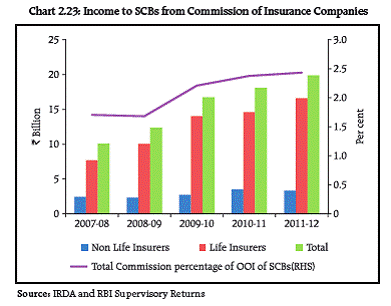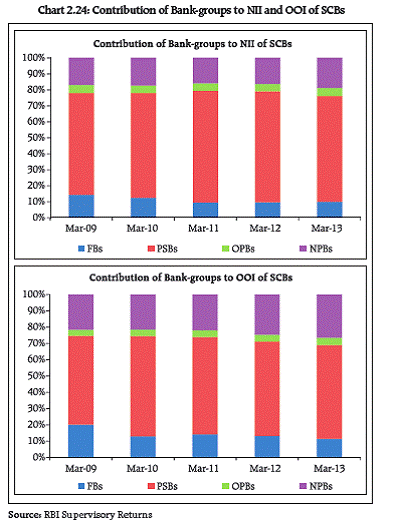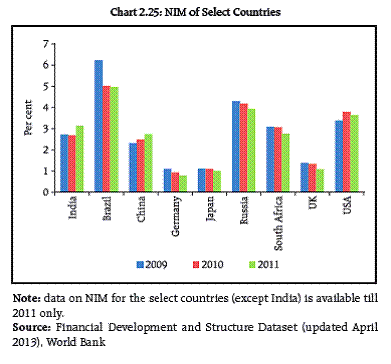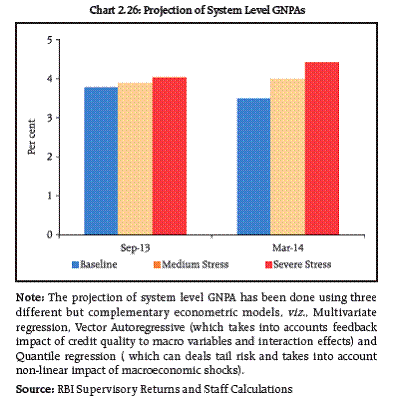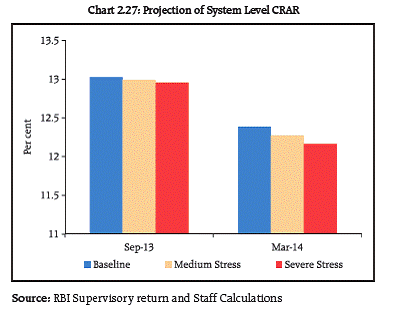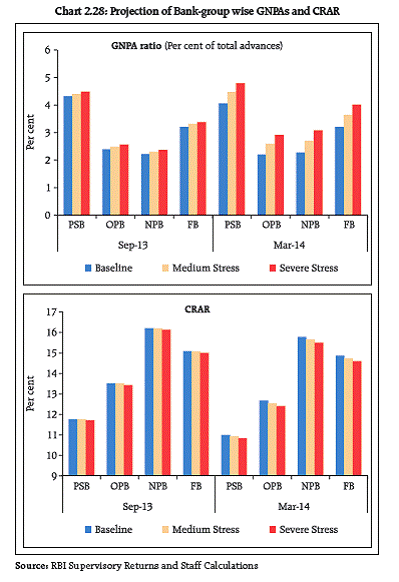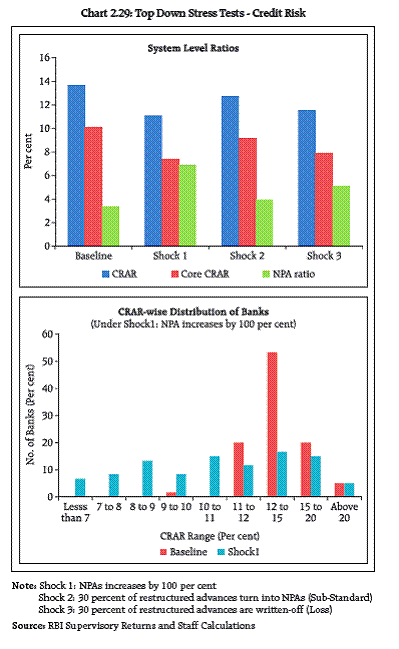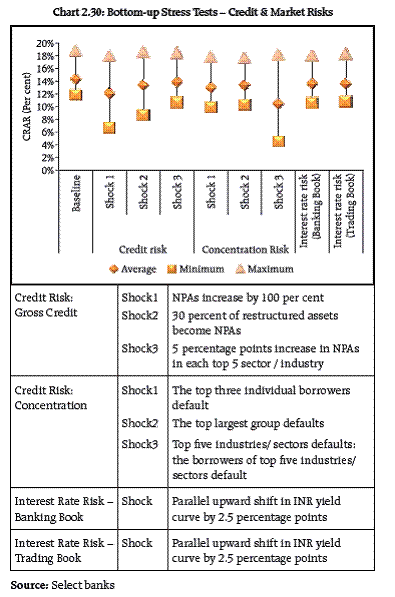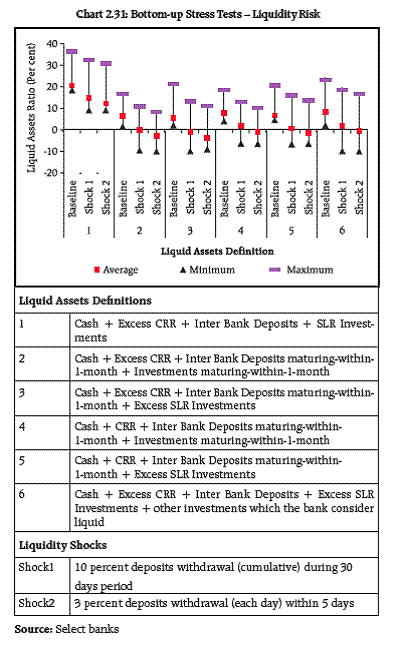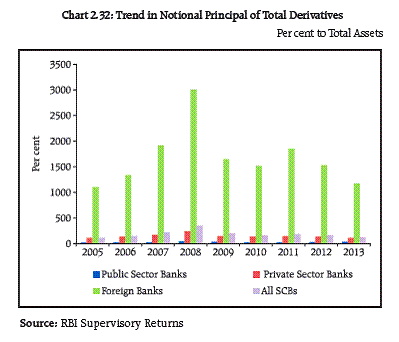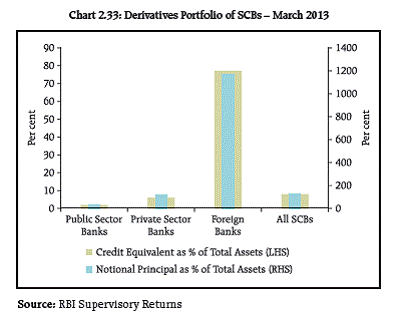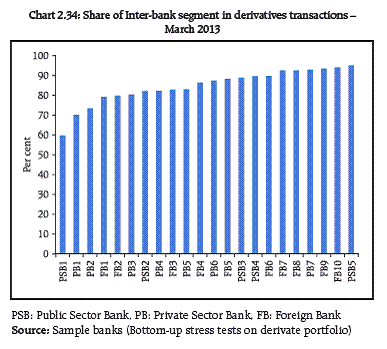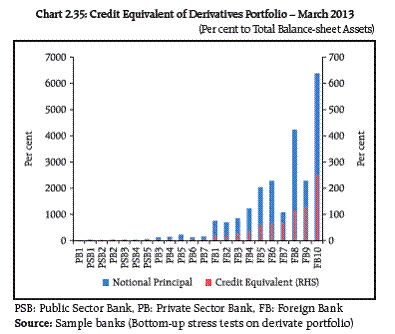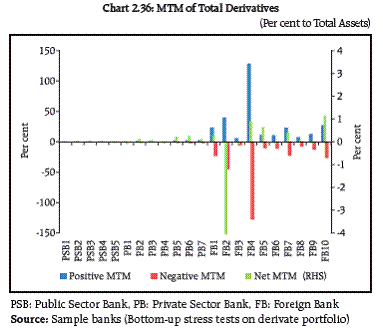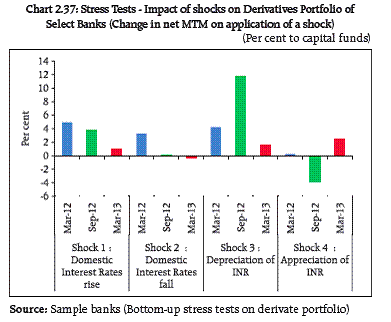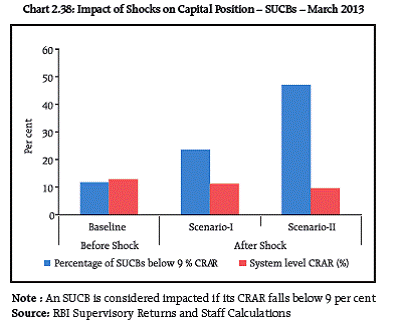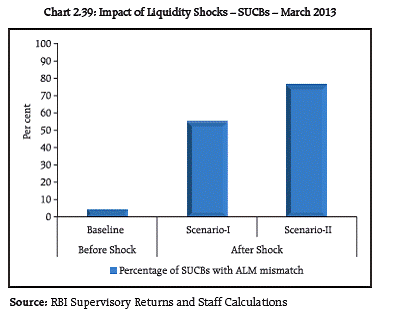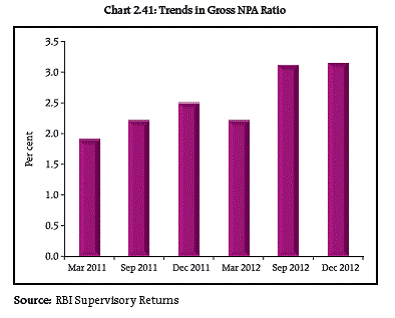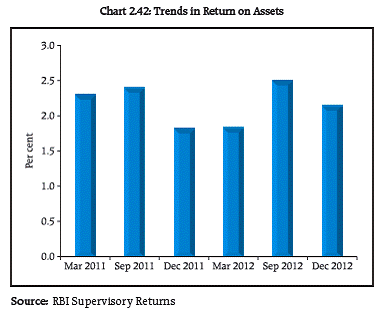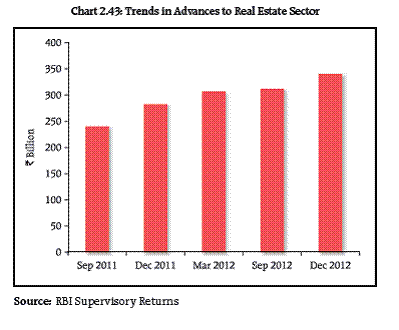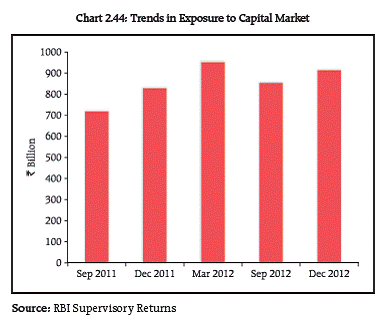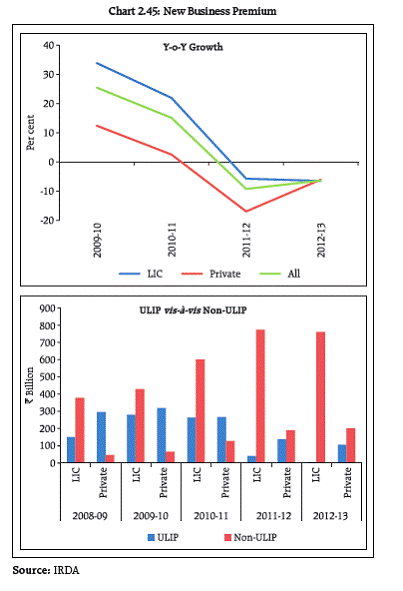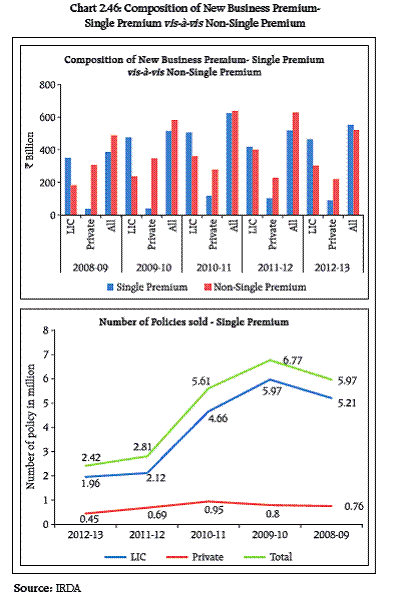 IST,
IST,
Chapter II : Financial Institutions: Soundness and Resilience
Risks to banking sector have increased since the publication of the last FSR in December 2012. The strain on asset quality continues, although it has shown some improvement during the quarter ended March 2013. The growth in credit and deposit, as well as changes in asset quality have shown significant ‘seasonality’. Various Banking Stability Measures, based on co-movements in banks’ equity prices, indicate that the distress dependencies within the banking system which were rising during last year, have shown some sign of easing. The inter-bank market continues to be highly interconnected as brought out by the network analysis. A simulation of liquidity and solvency contagion reveals that the failure of a large bank can significantly impact the banking system. Macro stress tests indicate that if the current macroeconomic conditions persist, the credit quality of commercial banks could deteriorate further. However, the comfortable position on the banks’ capital adequacy front has provided resilience as shown by the top-down stress testing exercises on various risks. The results of the bottom up stress tests (sensitivity analysis) carried out by select banks, also testified to the general resilience of the banks to different kinds of shocks. The new business premium of insurance sector continued to contract for the last two years. Single premium insurance policies account for a major part of the life insurance business especially of the Life Insurance Corporation. Persistency rates also continue to cause concern in life insurance business. New Pension System introduced by the Government of India with a view to develop the pension sector has shown steep growth in the subscriber base and corpus. Assessment of Risks - Banking Sector 2.1 The risks to the banking sector, as at end March 2013 have increased marginally since the publication of previous FSR1. The Banking Stability Indicator, which combines the impact on all major risk dimensions, shows an increase in vulnerability in the banking sector since September 2010 (Chart 2.1). An analysis of the components contributing to banking stability shows that tight liquidity, deteriorating asset quality and reducing soundness are the major contributors to the decline in stability of the banking system. This comparative position is reflected in the Banking Stability Map also (Chart 2.1). Distress Dependencies and Interconnectedness Banking Stability Measures (BSMs) – Distress Dependency Analysis 2.2 The financial system is conceptualised as a portfolio of a specific group of banks2, for the purpose of modelling distress dependencies, based on the premise that during times of distress, the financial position of banks tend to decline concurrently through direct and / or indirect links. These links mainly include mark-to-market asset values, interbank lending and information asymmetries. 2.3 The Banking Stability Measures (BSMs), based on the distress dependency structure among banks, use the technique of Banking System’s Portfolio Multivariate Density (BSMD)3 (Segoviano and Goodhart, 2009). The BSMD technique takes into account inter-dependent structure of distress, which captures both linear and non-linear distress dependencies among the banks in the system and provides a set of tools to measure: (i) common distress of the banks in a system and (ii) distress between specific banks. The BSMD technique uses both the individual and joint asset value movements of the portfolio of banks and the BSMD is derived from Probabilities of Distress (PoDs)4 of the banks, observed empirically, based on 99 per cent Value at Risk (VaR) of banks’ daily equity price return. 2.4 The BSMs presented in this section comprise of the Banking Stability Index, Toxicity Index and Vulnerability Index. While the Banking Stability Index depicts the common distress of the banks in a system, the Toxicity and Vulnerability Indices depict the distress between specific banks. Common distress in the system 2.5 The probability of distress of the entire banking system, as measured by Joint Probability of Distress (JPoD) has registered a marginal decline during last six months. Trends in the Banking Stability Index (BSI), that measures the expected number of banks that could become distressed given that at least one bank has become distressed, showed an upward trend (deteriorating conditions) from December 2010 till September 2012. A marginal decline in BSI registered since September 2012 indicating some sign of easing in interdependencies among banks, has again reversed in February 2013 (Chart 2.2). It may be observed the common distress in the system measured by JPoD and BSI is significantly lower at present, than the distress observed during the peak of the global financial crisis. The JPoD and the BSI not only take account of individual banks’ probabilities of distress, but these measures also embed banks’ distress dependence. Therefore, these measures may experience larger and nonlinear increases than those experienced by the PoDs of individual banks. Distress relationship among banks 2.6 The Toxicity Index (TI) is the average probability that a bank under distress may cause distress to another bank in the system, whereas, Vulnerability Index (VI) is the average probability of a bank coming under distress given distress in other banks in the system. Both the indices have shown a co-movement with that of BSI indicating signs of easing toxicity and vulnerability of the selected banks (Chart 2.3). Network Analysis5 The interbank market 2.7 The Indian Financial System is bank dominated. The market for interbank exposures (exposures between SCBs), stood at `9.8 trillion as at end March 2013. The public sector banks with 62 per cent share of the market comprised the largest segment, followed by the foreign banks whose share of the market was around 28 per cent. 2.8 Average interbank lending as a percentage of total assets stood at around 11 per cent while inter bank borrowing as a percentage of total outside liabilities stood at around 13 per cent. However, the exposure was significantly higher for some banks, making them vulnerable to solvency and liquidity shocks arising out of any instability in the overall banking system (Charts 2.4 and 2.5). 2.9 An analysis of the network of interbank call money market indicates a low level of tiering6 compared to the network of interbank exposures. The size of the market amounted to `213 billion as at end March 2013 and its network structure effectively demonstrates only two tiers with the banks in the core being the major lenders in the system. The structure of the network in the call money market indicates that the failure of any of the lenders in the inner core will have significant implications for the liquidity of the market. 2.10 The network of the interbank Certificate of Deposit (CD) exposures displays a higher degree of interconnectedness as compared to the call money market, though the level of tiering is low in this market as well. The connectivity ratio7 of the interbank CD market stood at 9 per cent, whereas the same ratio for the interbank call market was just above 1 per cent (Chart 2.6 and 2.7). These ratios are well below the connectivity ratio for the total interbank market which is around 25 per cent. The Non-Banking Financial Sector 2.11 In the broader financial system, the main nonbank institutions are the Asset Management Companies and the Insurance Companies. The combined investment/lending by these two sectors amounts to over `6.5 trillion, most of which is to banks. The exposure of these entities to the banking system makes them potentially vulnerable to solvency shocks arising from any instability in the banking system. 2.12 The business models of Non-Banking Financial Companies (NBFCs)8 make them largely reliant on banks for their liquidity requirements. Within the financial system, they are the second largest borrowing sector, after the banking sector. Total borrowing by this sector is close to `3 trillion, while the investment/ lending by NBFCs stood at around `1.2 trillion. The bulk of these exposures are fund based. The reliance of the NBFCs to banks makes them vulnerable to liquidity shocks arising from any instability in the banking system (Chart 2.8). Contagion Analysis 2.13 Contagion analysis with network tools is used to assess distress in the banking system due to insolvency of the net borrowers. The exercise is a stress test which reckons the impact of failure of a net borrower in the system without taking cognizance of the probability of failure of a bank. It is important to note that the trigger for contagion is the failure of a major player, the probability of such failure being subject to macroeconomic factors and its own financial position. In the well regulated Indian banking system, the probability of such failure is a tail event, especially since the prudential regulator is also in charge of systemic risk. 2.14 The extent of contagion caused by distress in a bank will vary depending on the criteria that is used to determine the condition under which a bank is treated as ‘distressed’, with more stringent distress conditions leading to a more severe contagion results. This is illustrated in the table below which shows the contagion impact using different distress conditions (Table 2.1). Liquidity contagion9 in the financial system 2.15 An analysis of the three main sectors in the financial system, i.e. the banking sector, the insurance sector and the mutual funds sector reveals that the failure of any institution which has large lending position will have significant downstream impact. As discussed in paragraph 2.11 above, the insurance companies and the asset management companies are fund providers in the financial system and any failure can cause severe liquidity stress in the system (Table 2.2). A stylised representation of how a liquidity contagion will play out is depicted in Chart 2.9 Scheduled Commercial Banks (SCBs) Trends in Credit and Deposit 2.16 The SCBs recorded lower credit growth on y-o-y basis at 15.1 per cent in March 2013 than in September 2012 (15.8 per cent) and March 2012 (16.9 per cent), respectively. However, the y-o-y deposits growth of all SCBs increased marginally to 14.4 per cent in March 2013 from 14.3 per cent of the September 2012 (Chart 2.10). Despite the lower credit growth during March 2013, the Credit-Deposit (C-D) ratio of SCBs improved to 76.5 per cent during the quarter from 74.3 per cent in September 2012, indicating greater share of credit in their incremental assets. 2.17 At the bank-group level, except foreign banks, all the other bank-groups recorded lower credit growth and higher deposit growth in March 2013 compared to September 2012. The credit growth of foreign banks increased sharply to 14.6 per cent in March 2013 from 6.5 per cent in September 2012, whereas, the deposit growth of this bank-group declined to 4.0 per cent in March 2013 from 8.2 per cent in September 2012. The public sector banks registered credit and deposits growth of 14.2 per cent and 14.0 per cent in March 2013, respectively (Chart 2.10). Seasonality in Credit and Deposit activities of Indian banks 2.18 It can be observed that the banks’ performance on credit delivery and deposit mobilisation improves during the last quarter of the financial year. The asset quality indicators also show an improvement during the last quarter of financial year. While there may be some business reasons for such a phenomenon, it is widely perceived that the banks adopt various strategies to improve their performance for the yearend balance sheets. In a competitive scenario, the incentive structures could be driving the banks towards ‘window-dressing’ practices. Chart 2.9: Liquidity Contagion10 in the Financial System 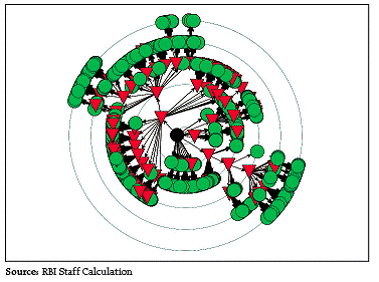 2.19 An empirical analysis of seasonal factors of credit, deposit, slippage ratio, recovery and write-off11 has been carried out to understand the behavioral aspects. The finding of this analysis shows that, credit and deposit, both have significant seasonality, which pulls them up during the last quarter of financial year (Chart 2.11). 2.20 The q-o-q growth in credit and deposit of SCBs increased to 7.3 per cent and 6.9 per cent in March 2013 from 4.6 per cent and 2.1 per cent of the previous quarter, respectively. However, the q-o-q growth in seasonally adjusted credit and deposit declined to 3.4 per cent and 2.9 per cent in March 2013 from 3.7 per cent and 3.2 per cent of the previous quarter, respectively. This shows that the improved credit and deposit growth during March 2013 was largely due to the seasonal factor (Chart 2.12). Chart 2.11: Seasonal Factors12 of Credit and Deposit 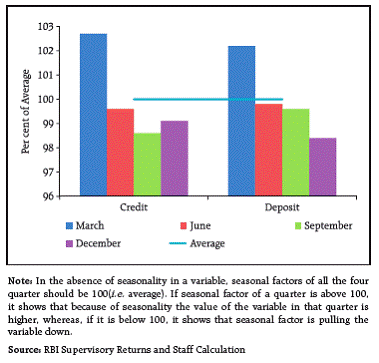 Sectoral Deployment of Credit 2.21 There were no major changes in the overall distribution of sectoral credit allocation over the last two years. The trends in credit flow to some select sectors like Agriculture, Exports, Medium and Small Enterprises (MSE), and NBFCs have been studied in this section. These sectors account for around 40 per cent of the total bank credit as at end March 2013 (Chart 2.13). The sectors under ‘Others’ include, advances to central and state governments, food credit, advances to public sector units, etc. 2.22 The growth in the credit to the agriculture declined sharply to 12.5 per cent in March 2013 from 29.8 per cent of September 2012. 2.23 Export credit continues to contract, an issue that has been engaging the attention of policy makers in the light of increasing trade deficit. The Reserve Bank has been initiating measures from time to time to direct credit to the sector at competitive rates. The recent report of a technical committee13 constituted by the Reserve Bank has recommended several measures to improve the flow of credit to export sector, reduce transaction costs and incentivise exports & export financing. 2.24 Credit growth to MSE sector, which has a large potential for employment generation, increased significantly to 25.6 per cent in March 2013 from 15.5 per cent and 7.6 per cent in September 2012 and March 2012, respectively. The increase in credit growth of MSE sector registered during the quarter needs to be sustained, for improving the overall credit deployment for this sector. The credit growth to retail housing also increased to 16.4 per cent from 13.0 per cent in September 2012 (Chart 2.14). 2.25 Bank credit to NBFCs recorded a decline in growth on y-o-y basis to 13.6 per cent in March 2013 from 32.5 per cent and 42.8 per cent recorded in September 2012 and March 2012, respectively. This decline is attributed to lower demand for auto & consumer loans, stricter norms on lending against gold, withdrawal of priority sector status for some loans given by SCBs to NBFCs for on-lending to specific purposes, etc. Soundness Capital Adequacy 2.26 The system level Basel II Capital to Risk Weighted Assets Ratio (CRAR) improved slightly to 13.8 per cent as at end March 2013 from 13.6 per cent as at end September 2012 (Chart 2.15). The y-o-y growth in risk weighted assets (RWA) of SCBs was at 17.1 per cent in March 2013 compared to 14.5 per cent in September 2012. The rise in capital was attributed mainly to increase in Tier I capital. 2.27 At the bank-group level, public sector banks continued to register the lowest CRAR at 12.4 per cent in March 2013 followed by old private banks (Chart 2.15). Leverage 2.28 The Tier I leverage ratio14 of all SCBs increased to 6.4 per cent in March 2013 from 6.1 per cent and 6.2 per cent of September 2012 and March 2012, respectively, due to the higher Tier I capital growth relative to the growth in the total assets (Chart 2.16). 2.29 An analysis of the bank-wise leverage15 was carried out, in conjunction with the trends in the riskiness of their assets. The leverage was measured as total assets to capital (using Tier I as well as Tier I & II), while the ratio of RWA to total assets was taken as an indicator of the degree of riskiness of the assets portfolio. It has been observed that the banks which have lower ratio of RWA to total assets tend to have a higher leverage (Chart 2.17). Estimation of Losses, Provisioning and Capital Adequacy 2.30 At present, banks in India follow ‘incurred loss model’ to recognise credit losses of banks. Under the approach, provision is made for loans, only on occurrence of an identifiable credit event. The timing and measurement of losses are, therefore, based on estimating losses that have been incurred as on the reporting date. This model does not permit recognising credit losses based on events that are expected to occur in the future and hence it is not a forward looking approach. As suggested by the BCBS, there is a need to move towards a new accounting standard, which is based on the concept of expected losses (EL) and unexpected losses (UL) to measure the potential losses in a credit portfolio (Box 2.1). Banks are expected to cover the UL by capital and EL by provisions. The EL is generally derived as the mean of the credit loss distribution and has a forwardlooking element16. 2.31 The estimated EL of SCBs at system level was around 2.0 per cent of total advances as at end March 2013 and is expected to rise to 2.3 per cent by September 2013 under baseline scenario (Table 2.3). The present level of total provisions17 being maintained by the SCBs at 2.6 per cent of total advances as at end March 2013, is adequate under the baseline scenario. The EL may further increase to 3.1 per cent under severe stress conditions by March 2014, leaving a gap between the present provisioning level and EL under heightened adverse macroeconomic conditions18. Therefore, it would be prudent for the SCBs to increase their provisioning from the present levels. On the other hand, the UL and expected shortfall of SCBs are estimated to be around 7.0 per cent and 7.1 per cent of total advances respectively for the quarter ended March 2013. The corresponding losses may further rise to 8.8 per cent and 9.0 per cent as at end March 2014 under severe stress scenario. The UL and expected shortfall are less than the Tier I capital to total advances ratio of 12.1 per cent maintained by SCBs as at the end of March 2013.
Expected Loss, Unexpected Loss and Expected Shortfall of Scheduled Commercial Banks in India The EL is generally derived as the mean of the credit loss distribution and has forward-looking element as it is capable of incorporating ‘through-the-cycle’ view of probability of default. A pictorial presentation of loss distribution depicting EL, UL and expected shortfall is given in the chart below. The following standard definitions have been used for estimation of these losses: Expected Loss (EL): The EL is the average credit loss that the banking system expects from their credit exposure. Unexpected Loss (UL): The UL at 100(1-α) per cent-level of significance is the loss may occur at the α-quantile of the loss distribution. Expected Shortfall (ES): When the distributions of loss (Z) are continuous, expected shortfall at the 100(1-α) per cent confidence level ( ESα (Z) ) is defined as, ESα (Z) = E[Z | Z≥VaRα (Z)]. Hence, Expected shortfall is the conditional expectation of loss given that the loss is beyond the VaR level. These losses were estimated as: Loss = PD X LGD X EAD Where, EAD = Exposure at Default, is the total advances of the banking system. EAD includes only on-balance sheet items as PD was derived only for on balance sheet exposures. LGD = Loss Given Default. Under baseline scenario, the average LGD was taken as 60 per cent as per the RBI guidelines on ‘Capital Adequacy – The IRB Approach to Calculate Capital Requirement for Credit Risk’. LGD was taken at 65 per cent and 70 per cent under medium and severe macro-economic conditions, respectively. PD = Probability of Default. PD was defined as gross non-performing advances to total advances ratio. Because of unavailability of data on number of default accounts, the size of default accounts (i.e. NPA amount) has been used for derivation of PDs. The above losses viz., EL, UL and ES, were estimated by using a simulated PD distribution. As a first step; an empirical distribution of the PD was estimated using Kernel Density Estimate, second; using the empirically estimated probability density function, 20000 random numbers were drawn based Monte Carlo Simulation and finally, for calculation of expected loss, unexpected loss and expected shortfall, PDs were taken as average PD, 99.9 per cent VaR of PD and average PD beyond 99.9 per cent loss region, respectively. Asset Quality 2.32 The asset quality of SCBs, which was deteriorating continuously, recorded an improvement in March 2013 quarter. The Gross Non-Performing Advances (GNPA) ratio of SCBs improved to 3.4 per cent as at end March 2013 against 3.6 per cent as at end September 2012. The net NPA ratio declined to 1.4 per cent as at end March 2013 from 1.6 per cent as at end September 2012. This decline in NPA was attributed to the lower slippage, improved recovery and higher write-off during the quarter (Chart 2.18). Change in classification for restructured advances with effect from April 1, 2015 may have some adverse impact on the NPAs, unless banks take preventive measures in this regard. 2.33 At the bank-group level, the GNPAs of public sector banks was highest and stood at 3.8 per cent as at end March 2013, followed by that of the foreign banks. The quarterly slippage ratio of public sector banks declined to 0.5 per cent for the quarter ended March 2013 from 0.8 per cent recorded during September 2012. Quarterly slippage of foreign banks increased to 0.3 per cent and 0.1 per cent for the corresponding periods. The old private banks registered highest quarterly recovery at 21.2 per cent during quarter ended March 2013 followed by the public sector banks at 9.1 per cent. All the bank groups, except new private banks, recorded higher write-off during the quarter ended March 2013 as compared to quarter ended September 2012 (Chart 2.18). Seasonality in Asset Quality 2.34 An empirical seasonal analysis shows that during the March quarter, the slippages of standard advances are more than the average slippages of all four quarters, but, the GNPA ratio declines during this quarter mainly because of the higher recovery and write-off of bad loans observed during the last quarter (March) of financial year (Chart 2.19). Restructuring of loans 2.35 The restructured standard loans of SCBs as proportion of their total loans have registered a marginal decline from 5.9 per cent as at end September 2012 to 5.7 per cent as at end March 2013. Among the bank groups, this ratio, at 7.1 per cent, was the highest for the public sector banks followed by old private banks. (Chart 2.20). 2.36 Industry and services sector account for a major proportion of restructured loans of the banking sector. As these sectors have a relatively higher share of total bank credit, the trends in restructuring of loans to these sectors make a bigger impact on the health of the banking sector. Within the industrial sector, a few sub-sectors, namely; Iron & Steel, Textile, Infrastructure, Power generation and Telecommunications; have become a cause of concern in recent times. In case of sectors like Aviation, though the incidence of restructuring is high, its share of bank credit is relatively low (Chart 2.21). Chart 2.19: Asset Quality - Seasonal Factors21 2.37 The increasing incidence of forbearance in the banking system especially in Europe has emerged as a concern in recent times against the backdrop of a slowdown in the global economy. Forbearance refers to the act of granting a concession to the borrower by the lender (bank), in view of some economic or legal reasons related to temporary financial difficulties being faced by the borrower. While forbearance is essential and good in the case of viable ventures, forbearance to avoid classification as NPL or simply keeping zombie companies alive, leads to inefficient allocation of resources and eventual problems for the lender. 2.38 The previous FSR had covered the unhealthy trends in restructuring of advances by banks in India, especially the public sector banks. In this context the recommendations of a Reserve Bank Working Group22 to review the restructured loans have been accepted and the extant asset classification benefits available on restructuring will be withdrawn effective from April 1, 2015 - with the exception of provisions related to changes in date of commencement of commercial operation (DCCO) in respect of infrastructure and non-infrastructure project loans. 2.39 The Working Group had also recommended that, till such time the regulatory forbearance on asset classification is dispensed with, the provision requirement on such accounts should be increased from the present 2 per cent to 5 per cent, in order to prudently recognise the inherent risks in restructured standard assets in the interregnum. The Reserve Bank, therefore has increased23 the provision on restructured standard accounts to 2.75 per cent from 2.00 per cent. The provision has been increased to 5 per cent in respect of new restructured standard accounts (flow) with effect from June 1, 2013 and in a phased manner for the stock of restructured standard accounts as on March 31, 2013. Profitability 2.40 The profitability of all SCBs, measured by return on assets (RoA) and return on equity (RoE) declined to 1.0 per cent and 12.8 per cent in March 2013 from 1.1 per cent and 13.4 per cent in March 2012, respectively. The lower growth in profit after tax (PAT) was mainly attributed to the lower y-o-y growth in net interest income (NII) at 11.0 per cent in March 2013 against 15.8 per cent in the previous year. The decrease in NII is accompanied by a reduction in the net interest margin (NIM) to 3.0 per cent in March 2013 from 3.1 per cent in the previous two years. The SCBs have seen a faster growth in their other operating income (OOI), with the y-o-y growth increasing to 13.8 per cent in March 2013 from 7.4 per cent in the previous year (Table 2.4). 2.41 The contribution of NII to total operating income(TOI) declined marginally to 72.1 per cent in 2012-13 from 72.6 per cent in the previous year, whereas, contribution of OOI to TOI increased to 27.9 per cent in 2012-13 from 27.4 per cent in the previous year. This rise in the contribution of OOI to total income was attributed to the higher contribution recorded from security trading (10.5 per cent in 2012- 13 against 3.6 per cent in the previous year) and miscellaneous income (Table 2.5). 2.42 Among the major bank groups, the contribution of NII to the TOI is highest in the case of the public sector banks followed by old private banks; whereas the contribution of OOI to TOI is highest in the case of new private banks followed by foreign banks (Chart 2.22). 2.43 Another emerging area that is adding to banks’ OOI is commission on account of insurance business. For the year 2011-12, banks accounts for `19.9 Billion, which is 9.7 per cent of total commission paid by insurers (life as well as non-life) and 2.4 per cent of the OOI of all SCBs (Chart 2.23).
2.44 The contribution of public sector banks as a bank-group, to NII and OOI of all SCBs, declined to 66.3 per cent and 57.5 per cent in March 2013 from 69.3 per cent and 58.1 per cent in the previous year, respectively. The contribution of new private banks to NII and OOI of all SCBs increased to 18.7 per cent and 26.5 per cent in March 2013 from 16.3 per cent and 24.6 per cent in the previous year, respectively (Chart 2.24). 2.45 The present levels of NIM and spread of the SCBs in India as a whole, may indicate that there is scope for banks to improving their efficiency. A comparison of NIM, for the three years through 2011, of select countries shows that NIM of banks in India is comparable to that of BRICS countries (Chart 2.25). Resilience - Stress Tests 2.46 The resilience of the Indian banking system to macroeconomic shocks was tested through a series of macro stress tests for credit risk at system, bankgroup and sectoral levels. These tests are based on baseline scenario and two adverse (medium and severe) risk scenarios (Table 2.6). The adverse scenarios were derived based on up to 1 standard deviation for medium risk and 1.25 to 2.0 standard deviations for severe risk (10 years historical data). Credit Risk - System Level 2.47 The macro stress tests for credit risk suggest that under baseline scenario, GNPA ratio of all SCBs is expected to rise to around 3.8 per cent by September 2013 from 3.4 per cent of March 2013, whereas, under the assumed improved macroeconomic condition for the financial year (FY) 2013-14 (compared to 2012-13), GNPA ratio may decline subsequently to 3.5 per cent by March 2014. However, under severe stress scenario, GNPA ratio may rise to 4.4 per cent by March 2014 (Chart 2.26). Under such severe risk scenario, the system level CRAR of SCBs could decline to 12.2 per cent by March 2014, but will still remain above the regulatory requirement of 9 per cent (Chart 2.27). This projection of GNPAs, however, does not capture the likely impact of the withdrawal of forbearance for restructured loans. Credit Risk - Bank Group Level 2.48 Among the bank-groups, public sector banks are projected to register the highest GNPA ratio. Under baseline scenario, the GNPA of public sector banks and foreign banks may rise to 4.1 per cent and 3.2 per cent by March 2014 from 3.8 per cent and 3.0 per cent in March 2013, respectively. Whereas, GNPA ratio of both old private banks and new private banks may rise to 2.3 per cent by March 2014 from 1.9 per cent in March 2013 (Chart 2.28).
2.49 CRAR of PSBs, which is the lowest at around 12 per cent, may decline to 10.8 per cent by March 2014 under severe stress scenario. Under such severe risk scenario, the CRAR of new private sector banks, old private banks and foreign banks may decline to 15.5 per cent, 12.4 per cent and 14.6 per cent from 17.5 per cent, 13.8 per cent and 17.0 per cent recorded as at end of March 2013 quarter, respectively. However, even under severe stress scenario, the CRAR of all the bank groups is seen to remain above the regulatory requirement of 9 per cent (Chart 2.28). Credit Risk - Sector Level 2.50 Macro stress test of sectoral credit risk revealed that, among the selected seven sectors, Construction and Agriculture are expected to register the highest NPA ratios of around 4.7 to 4.8 per cent by March 2014, followed by Iron & Steel sector. The adverse macroeconomic shocks seem to have maximum impact on Iron & Steel and Construction followed by Engineering (Table 2.7).
Top Down Stress Tests - Bank Level 2.51 A number of single factor sensitivity stress tests (top-down) were carried out on SCBs (60 banks comprising 99 per cent of total banking sector assets) to assess their vulnerabilities and resilience under various scenarios. The resilience of the commercial banks in respect of credit, interest rate and liquidity risks were studied through top down sensitivity analysis by imparting extreme but plausible shocks. The results are based on March 2013 data27. The same set of shocks was used by 25 select SCBs (comprising about 75 per cent of total assets) to conduct bottom up stress tests. The results of the bottom up stress tests broadly reflected those of the top down stress tests and reconfirmed the resilience of the banking system to a wide range of shocks. Credit Risk 2.52 The impact of different static shocks for banks as on March 2013 shows that the system level CRAR remained above the required minimum of 9 per cent. The capital losses at the system level could be about 29 per cent in the case of severe stress condition (Shock 1). The stress test results, further showed that some banks would fail to maintain required CRAR under stress scenarios (Chart 2.29). 2.53 The stress tests on credit concentration risk of banks show that the impact under various stress scenarios is not significant. The impact on CRAR under the assumed scenarios of default of top three individual borrowers and default of top group borrower would be 240 and 185 basis points respectively and the system should be able to withstand this default. However, at individual level, a few banks with high concentration might be seriously impacted under stressed conditions. Interest Rate Risk 2.54 The interest rate risk for the trading book (direct impact) under various stress scenarios is manageable with reduction in CRAR by 1 percentage points at the system level, though a few small banks would be impacted adversely. The major impact is due to upward movement (2.5 percentage points) of yield curve, especially for the low maturity buckets because of their relatively large size. For the same stress scenario the capital position of the banking system gets impacted by about 2.6 percentage points for the banking book. Liquidity Risk 2.55 To capture the impact on the liquidity risk, analysis has been done with five definitions of liquid assets28. As per these definitions, the liquid assets comprise of Cash, CRR, Inter-bank-deposits and Investments. Different liquid asset ratios are arrived at using various definitions under the baseline scenario. The stress scenarios are constructed to test the ability of banks to meet a run on their deposits using only their liquid assets. It is assumed that (1) ten per cent total deposits would be withdrawn in 10 days and (2) three per cent deposits would be withdrawn in each day for 5 days. Under the stress scenarios, there were indications of deterioration in the liquidity position of banks though SLR investments and CRR helped the banks to ward off the liquidity pressure. Bottom Up Stress Tests 2.56 The results of the bottom up stress tests carried out by select banks also testified to the general resilience of the banks to different kinds of shocks. As in the case of top down stress tests, the impact of the stress tests was relatively more severe on some banks with their stressed CRAR position falling below the regulatory minimum (Chart 2.30). 2.57 The results of bottom up stress tests for liquidity risk show significant impact of liquidity shocks on select banks. The results also reflect that SLR investments, and CRR deposits to some extent, helped the banks to sustain against the liquidity pressure from sudden and unexpected withdrawal of deposits by depositors (Chart 2.31). Derivatives Portfolio of Banks 2.58 The derivatives portfolio of banks in India grew sharply in the years leading up to the global financial crisis. Though the portfolio size has shrunk since 2008, it still remains large with the outstanding notional principal of the derivatives portfolio of banks constituting over 120 per cent of banks’ total assets as on March 31, 2013. However, the credit equivalent of derivate portfolio is about 8 per cent of the balance sheet assets. The foreign banks as a group account for about 80 per cent of the outstanding notional principal in the derivatives market, whereas their share in the balance sheet assets of the banking system is only 7 per cent. The size of outstanding notional principal and their credit equivalent for foreign banks is about 1200 and 80 per cent of total assets respectively (Chart 2.32 and 2.33). 2.59 Among the sample banks29, the majority of outstanding derivative transactions are interbank transactions. The interbank segment of the derivatives portfolio constituted about 85 per cent of the total outstanding derivatives as at March 2013 (Chart 2.34). 2.60 The credit equivalent of derivative portfolio of public and private sector banks were not very significant. However, the credit equivalent for foreign banks were large (Chart 2.35). 2.61 The mark to market (MTM) value of the derivatives portfolio for the banks in the sample varied – with most banks registering positive net MTM with the exception of a few large negative Net MTM (Chart 2.36). 2.62 A series of stress tests (sensitivity analysis) on derivative portfolios were conducted with the reference date as March 31, 2013. The banks in the sample reported the results of four separate shocks on interest rates and foreign exchange rates. The shocks on the interest rates ranged from 1.0 percentage points to 2.5 percentage points, while that for foreign exchange rates was kept at 20 per cent. The stress tests were carried out on individual shocks, on stand-alone basis. The results showed that the average net impacts of shocks on sample banks were not very high (Chart 2.37). Scheduled Urban Co-operative Banks (SUCBs) 2.63 The CRAR of SUCBs has remained at 12.7 per cent as at end March 2013, whereas, GNPA ratio declined to 5.3 per cent as at end March 2013 from 6.1 per cent in September 2012. The annualised return on assets (RoA) declined from 1.1 per cent in the quarter ended September 2012 to 0.9 per cent in the quarter ended March 2013. The Liquidity Ratio for the SUCBs declined marginally to 34.0 per cent in March 2013 from 34.1 per cent in September 2012. However, the Provision Coverage Ratio (PCR) of SUCBs improved to 73.7 per cent in March 2013 from 66.3 per cent in September 2012 (Table 2.8). 2.64 Stress tests for assessment of credit risk were carried out for SUCBs using the data as on March 31, 2013. The impact of credit risk shocks on the CRAR of the SUCBs was observed under two different scenarios assuming an increase in the gross NPA ratio by 50 per cent and 100 per cent respectively. The results show that SUCBs could withstand shocks assumed under the first scenario easily, though they would come under some stress under the second scenario (Chart 2.38). 2.65 Stress tests on liquidity risk were carried out under two different scenarios assuming increase in cash outflows in the 1 to 28 days time bucket by 50 per cent and 100 per cent respectively. It was further assumed that there was no change in cash inflows under both the scenarios. The SUCBs would be impacted as a result of the stress if the mismatch or negative gap (i.e. the cash inflow being less than the cash outflow) in the 1 to 28 days time bucket exceeds 20 per cent of outflows. The stress test results indicate that the SUCBs would be significantly impacted even under the less severe stress scenario (Chart 2.39).
Non-Banking Financial Companies (NBFCs) 2.66 The NBFCs sector under Reserve Bank‘s regulation is dominated by non-deposit taking systemically important NBFCs (NBFC-ND-SIs), which account for around 90 per cent of the sector in terms of asset size. Capital Adequacy 2.67 The CRAR norms were made applicable to NBFCs-ND-SI w.e.f April, 200730, in terms of which every systemically important non-deposit taking NBFC is required to maintain a minimum capital, consisting of Tier-I and Tier- II capital, of not less than 15 per cent of its aggregate risk-weighted assets. The aggregate CRAR of the NBFCs-ND-SI sector stood at 26.8 per cent for the quarter ended December 2012 (27.4 per cent in the previous quarter ended September 2012) (Chart 2.40). Asset Quality 2.68 The GNPA ratio of the NBFCs-ND-SI sector stood at 3.2 per cent for the quarter ended December 2012 as against 2.5 per cent for the same quarter in the preceding year. Trends in GNPA ratio is given in Chart 2.41. Profitability 2.69 The ROAs (net profit as a percentage of total assets) of the NBFCs-ND-SI sector stood at 2.1 per cent for the quarter ended December 2012 as compared with 1.8 per cent for the same quarter in the previous year (Chart 2.42). Real Estate Exposure 2.70 Advances of NBFCs-ND-SI to real estate sector on an average accounted for 4.5 per cent of total advances to this sector. Trends in advances to real estate sector in absolute terms are furnished in Chart 2.43. Capital Market Exposure (CME) 2.71 Capital market exposure includes (i) investments in listed instruments and (ii) advances to capital market related activities. CME of the NBFCs-ND-SI sector on an average accounted for 8.8 per cent of total assets of the sector, while CME to own funds of the sector accounted for 34.0 per cent (Chart 2.44). Stress Tests - Credit Risk System level (NBFC-D and NBFC-ND-SI) 2.72 Stress tests on credit risk for NBFCs (includes both deposit taking and ND-SI sectors) for the period ended December 2012 were carried out under two scenarios (i) where gross NPA increased two times and (ii) gross NPA increased 5 times from the current level. It was observed that in the first scenario, CRAR dropped by 1.1 percentage points from 21.7 per cent to 20.6 per cent while in the second scenario CRAR dropped by 4.4 percentage points (CRAR dropped from 21.7 per cent to 17.3 per cent). It may be concluded that even though there will be a decline in CRAR under both the scenarios, it will remain above the minimum required level of 15 per cent. Select NBFCs 2.73 Stress tests on credit risk for individual NBFCs for the period ended December 2012 was also carried out under the same scenarios as used for system level stress tests. Under the first scenario, it was observed that CRAR in respect of 3.5 per cent companies was less than minimum regulatory requirement of 15 per cent while in the second scenario, CRAR in respect of 8.9 per cent companies went under 15 per cent. Insurance Soundness 2.74 The soundness of insurance companies is indicated by solvency ratio. During the first three quarters of the financial year 2012-13, the life and non-life insurance companies comfortably maintained the minimum required solvency ratios of 1.5 and 1.3, respectively. Business operations 2.75 The total premium collected by life insurance companies during the first three quarters of 2012-13 was `1.80 trillion out of which LIC accounted 71.9 per cent. During the same period, total premium collected by non life insurance companies (excluding GIC) was `513.88 billion, out of which 52.5 per cent was contributed by the four companies in the public sector. Life Insurance 2.76 The business of the life insurance sector, measured in terms of new business premium continued to contract for the last two years. The new business premium contracted by 6.3 per cent on y-o-y basis in the FY: 2012-13 (Chart 2.45). This contraction was observed in both public (i.e. Life Insurance Corporation of India (LIC)) and private sectors. The profitability of the life insurance companies had also declined during the first three quarters of 2012-13 from the previous year. A major shift in the sector has been the move away from ULIP products, which is especially evident in the private sector. Single Premium Policies 2.77 A major part of the new business premium of LIC is from single premium policies, hovering around 60 per cent of the total premium. Since 2010 -11, private insurers have also expanded their single premium business to about 30 per cent of the total. Overall contribution of single premium business for the life insurance sector increased to 51.4 per cent during 2012-13 from 45.2 per cent of the previous year (Chart 2.46). 2.78 From Chart 2.46, it can be observed that the number of single premium policies sold is declining with increase in premium indicating rising ticket size of single premium policies. Persistency 2.79 Life insurance policies being long term in nature, it is necessary to put in place measures to ensure that they remain in force throughout their life. Persistency31 of life policies is, however, a problem globally due to the following issues i) during the life of the policy, there might be better products with more beneficial features available in the market, or ab initio the product was not appropriate to the insured’s requirements over the lifetime; ii) extraneous factors like change in the policyholder’s economic profile, job, etc., and iii) poor after- sales service due to attrition of agents, etc., IRDA has been initiating measures to improve the persistency in the Indian life insurance market, especially for post sales service of orphan policies. This has resulted in some improvement. Pension Fund 2.80 The New Pension System (NPS) introduced by the Government of India with a view to develop the pension sector, is mandatory for all new recruits to the Government (except armed forces) with effect from January 1, 2004 and has also been rolled out to all citizens with effect from May 1, 2009 on a voluntary basis. During March 2010 and March 2013 the subscriber base of NPS grew by 522.9 per cent, whereas, the corpus increased by 538.0 per cent, indicating a steep growth pattern in the subscriber base and corpus during the short time (Table 2.9).
2.81 The fast growing subscriber base and corpus have been accompanied with notable returns. The weighted average return as on March 31, 2013 calculated on the basis of Net Asset Value of the NPS Schemes was in the range of 8.4 per cent to 14.2 per cent (Table 2.10). 2.82 The 2013-14 budget estimated a total outflow of `707.26 billion on pensions of central government employees alone, which is an increase of 10.79 per cent over the revised estimate of `638.36 billion for 2012-13. The outflows are expected to rise as the cohort of recruits between 1970s and 1980s retire. In the case of several Defined Benefit (DB) schemes, currently under implementation and newly announced (mostly in the government sector), the lack of liability computation especially in a world of rising life expectancy can be a potential source of fiscal stress in years when there are large payouts.
1December 2012 - with reference to data as at end September 2012. 2Study is based on 15 major banks have been selected for which equity price data are available. These represent about 60 per cent of total assets of scheduled commercial banks in India. 3For details please refer to the Annex-2. 4The PoDs for banks were estimated from their equity return distributions. Under this approach, first, banks’ historical distributions of equity returns are estimated. Then, the probability of returns falling under the historical worse 1 per cent of the cases (99 VaR) is quantified. Therefore, the PoD of a specific bank represents the probability that the bank’s equity return would fall in the tail region (historical one percentile). 5The analysis of the financial system is based on a sample size of 165 institutions. This includes all the SCBs and select Insurance Companies, Asset Management Companies, Urban Cooperative Banks, NBFCs and specialized financial institutions. The Network model used in the analysis has been developed by Professor Sheri Markose (University of Essex) and Dr. Simone Giansante (Bath University) in collaboration with the Financial Stability Unit, Reserve Bank of India. 6For details on tiering and Network Structures, please refer to the Annex-2. 7Connectivity ratio is measured as the actual number of connections to all total possible connections in a network. 8Sample size includes 35 top (both deposit taking and non deposit taking) NBFCs in the country. 10The black ball in the centre represents the initial trigger institution. Consequent to this trigger institution coming under duress, there is a liquidity stress in the system. Red triangles are the institutions which even after using its liquidity buffers and callable assets cannot tide over the stress. The green balls from which further contagion emanates (represented by an arrow) are the institutions which overcomes the stress using both its buffers and callable assets. The green balls which do not cause any contagion are the institutions which prevail over the stress by just using their liquidity buffer. 11Findings on seasonality in the asset quality are discussed in the Para No. 2.35. 12Seasonal Factors are estimated using X12-ARIMA method. 13Report of the Technical Committee on Services/Facilities to Exporters. 14Tier I leverage ratio is defined as the ratio of Tier I capital to Total Assets, under Basel III. Higher the ratio, lower the vulnerability. 15The usage of leverage here is different from the leverage ratio (as defined under Basel III). The leverage is taken as the ratio of total assets to capital. 16 Internationally, it is recommended to use estimated losses (EL & UL) approach for the purpose of making provisions and capital, for the next one year. For this purpose, PD is derived based on annual slippage. As the purpose of this study is to judge the adequacy of provisioning and capital levels being maintained by SCBs and not to estimate the required level of provisions and capital to be maintained for next one year, the PDs being used here is based on GNPA. 17Total Provisions include provisions for credit losses, risk provision for standard advances and provisions for restructured standard advances. 18The stress scenarios have been defined in Table 2.6 under macro-stress tests (Para No. 2.46). 19Quarterly recovery ratio is defined as percentage recovery during the quarter to the NPA at the beginning of the quarter. 20Quarterly write-off ratio is defined as percentage write-offs during the quarter to the NPA at the beginning of the quarter. 21Seasonal Factors are estimated using X12-ARIMA method. 22Report of the Working Group to review the existing prudential guidelines on restructuring of advances by banks/financial institutions. 23/documents/87730/39710850/CDRS30052013F.pdf 24Net Interest Margin(NIM): NIM of SCBs is derived by taking weighed average of bank wise NIM, weighted by asset size. 25Spread between Yield on Advances & Bills Discounted and Cost of Customer Deposits. 26These stress scenarios are stringent and conservative assessments under hypothetical-severely adverse economic conditions and should not be interpreted as forecasts or expected outcomes. 27For details on stress tests, please refer to the Annex-2. 28Please refer definitions 1 to 5 given in the footnote of Chart 2.31. 29Stress tests on derivatives portfolios were conducted for a sample of 22 select banks. Details are in Annex-2. 30Vide Notification No. DNBS.193 DG (VL) 2007, dated 22-02-2007 31Percentage of an insurance company’s already written policies remaining in force, without lapsing or being replaced by policies of other insurers. |
|||||||||||||||||||||||||||||||||||||||||||||||||||||||||||||||||||||||||||||||||||||||||||||||||||||||||||||||||||||||||||||||||||||||||||||||||||||||||||||||||||||||||||||||||||||||||||||||||||||||||||||||||||||||||||||||||||||||||||||||||||||||||||||||||||||||||||||||||||||||||||||||||||||||||||||||||||||||||||||||||||||||||||||||||||||||||||||||||||||||||||||||||||||||||||||||||||||||||||||||||||||||||||||||||||||||||||||||||||||||||||||||||||||||||||||||||||||||||||||||||||||||||||||||||||||
Page Last Updated on:






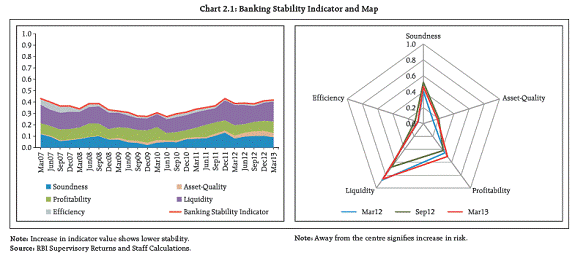
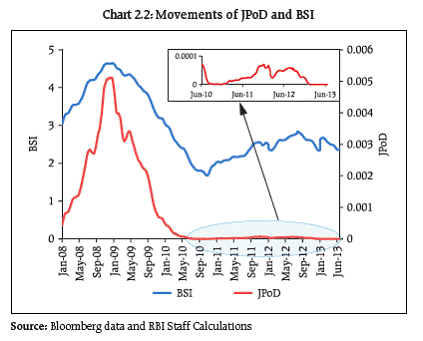
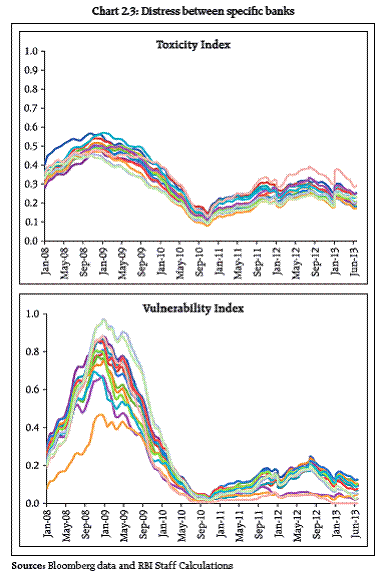
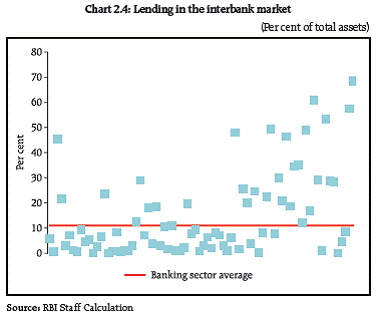
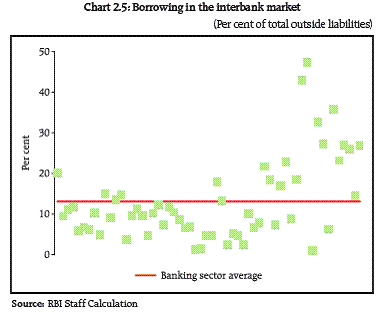
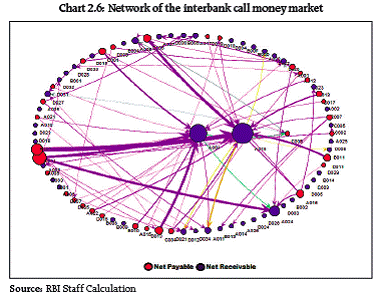
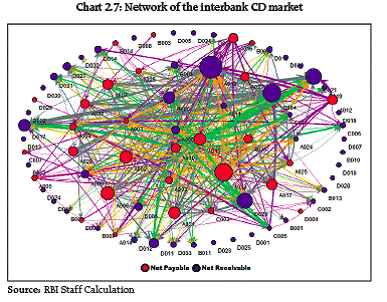
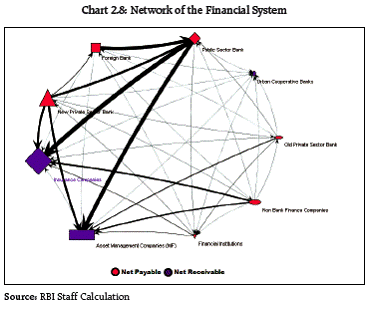
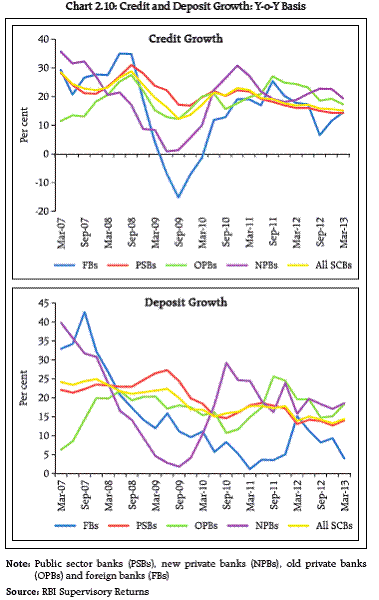
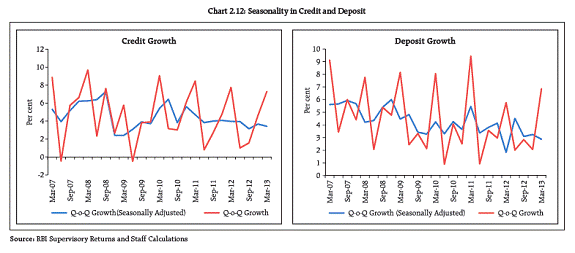

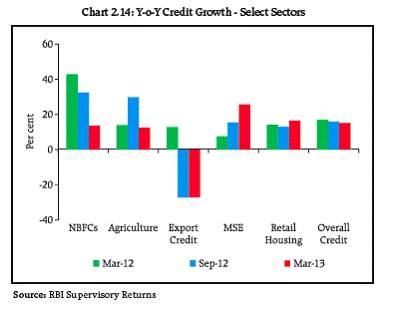
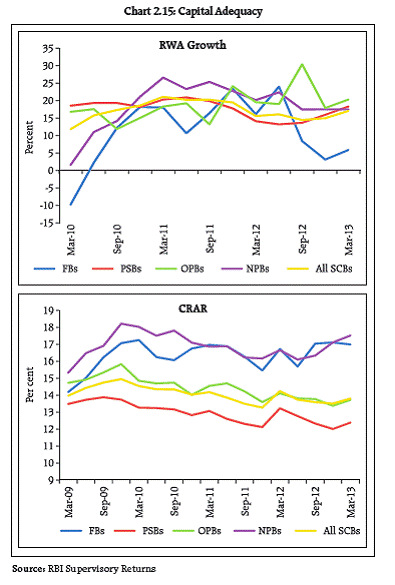
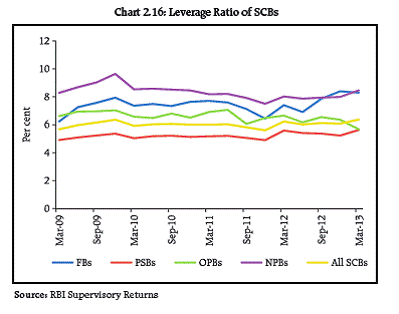
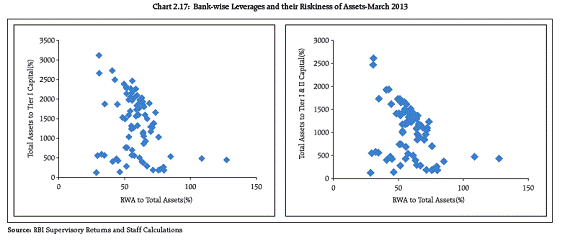
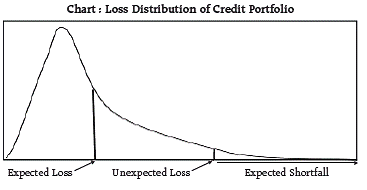

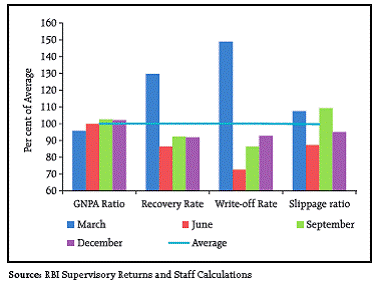 \
\